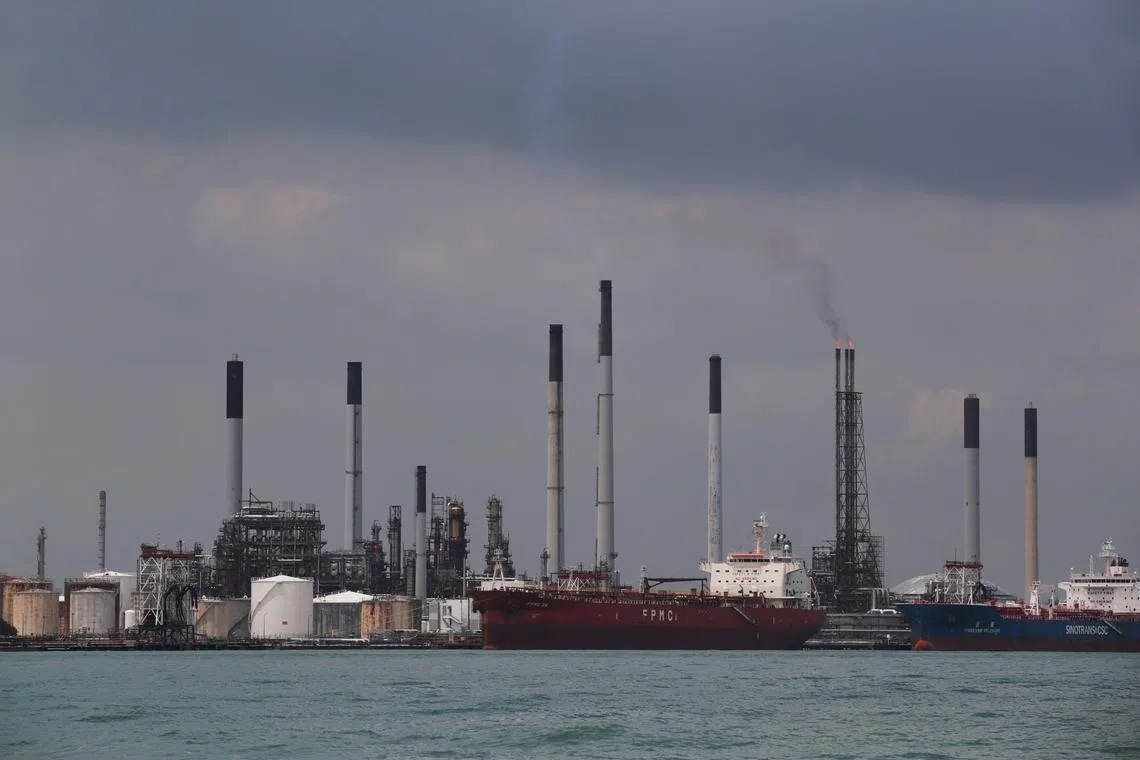S’pore keen to work with regional partners to capture, store carbon emissions: SM Teo
Sign up now: Get ST's newsletters delivered to your inbox

By capturing and storing carbon dioxide emissions, Singapore could help to decarbonise these sectors more effectively.
PHOTO: ST FILE
Follow topic:
SINGAPORE – Singapore is keen to work with regional partners to capture carbon emissions at source and store them deep underground to ensure that planet-warming carbon dioxide is not released into the atmosphere, said Senior Minister Teo Chee Hean.
Such carbon capture and storage (CCS) solutions are not new, but he said there is growing international recognition that CCS can play an important role in achieving significant reductions in industrial emissions.
“Countries in the region, such as Australia, Brunei, Indonesia and Malaysia, have strong geological potential for carbon dioxide storage, and some of our regional partners have announced plans to develop as regional CCS hubs,” Mr Teo said in Parliament on Feb 28.
By capturing and storing carbon dioxide (CO2) emissions from hard-to-abate sectors like the power, industrial and chemical sectors, Singapore could help to decarbonise these sectors more effectively.
“We are keen to work with like-minded partners on pathfinder projects to catalyse the development of such regional hubs,” he added.
He was responding to Mr Liang Eng Hwa (Holland-Bukit Timah GRC) and Ms Poh Li San (Sembawang GRC) on how the Government is turning its ambitions into action, and how the Government is supporting businesses and households in the green transition.
In 2022, Singapore announced enhanced climate targets, committing to reduce emissions by 2030 to 60 million tonnes of carbon dioxide equivalent, and to achieve net-zero emissions by 2050.
On Feb 15, Singapore became the first country to sign a letter of intent with Indonesia to collaborate on the cross-border capture and storage of CO2. This means that if the agreement comes into force, Singapore firms can ship or pipe their CO2 emissions to Indonesia for storage there.
The Government is also supporting businesses and households in the green transition, for instance, by spurring them to adopt more energy-efficient options
Enhancements will be made to the climate-friendly households programme, which helps households to offset the upfront costs of switching to more energy- and water-efficient appliances, said Mr Teo.
Currently, the scheme applies to only one- to three-room Housing Board flats, with each household receiving $225 in Climate Vouchers to buy more energy-efficient appliances.
As at December 2023, more than 136,000 households had claimed the vouchers.
The Energy Efficiency Grant has also been expanded. Since its launch in 2022, the grant has supported local companies in food services, food manufacturing and retail by defraying up to 70 per cent of their purchase of energy-efficient appliances such as LED lighting, air-conditioners and refrigerators.
Today, the grant is also open to companies in the manufacturing, construction and maritime sectors, as well as data centres and their users, as announced in Budget 2024 on Feb 16.
More details will be shared during the upcoming debates on the budget for the Ministry of Trade and Industry (MTI) and the Ministry of Sustainability and the Environment (MSE).
Climate change could also have wider implications on Singapore’s economy, said Mr Teo.
In Parliament on Feb 28, Mr Dennis Tan (Hougang) brought up how melting sea ice in the Arctic – at its current rate of decline of 13 per cent a year – could create more viable shipping routes between Europe and the Pacific. This could threaten Singapore’s position as a leading transshipment port.
The Northern Sea Route essentially creates a passage for ships in the Arctic region, and the opening of the high Arctic all year round shaves 30 per cent off travel time through the conventional Suez Canal-Malacca Strait route, and has implications for global shipping.
Mr Teo replied that the commercial viability of Arctic routes remains low. In 2022, only 43 transit voyages were made through the Northern Sea Route, fewer than 85 transit voyages in 2021.
But either way, Singapore’s port will have to be more efficient and better-connected to compete, he noted.
Future-ready public service division
Meanwhile, during the debate on the budget for the Prime Minister’s Office, Mr Chan Chun Sing, who is the Minister-in-charge of the Public Service, said a “forward-looking and future-ready public service” is central to Singapore’s success.
The public service has been re-organising to become more “mission-centric” to address complex, interdependent issues, added Mr Chan.
For instance, the establishment of the National Climate Change Secretariat (NCCS) in 2010 has helped the whole-of-government approach to sharpen its focus on climate change more effectively.
For instance, NCCS worked with MSE to develop the Singapore Green Plan 2030
In 2019, the Public Sector Science and Technology Policy and Plans Office was formed to better harness the potential of new technologies, and the Government is seeing the fruits of these efforts, noted Mr Chan.
For example, robots are increasingly being deployed in buildings for services such as cleaning and security, but they cannot communicate with each other because of different manufacturers’ proprietary software.
The office launched an initiative to deploy a universal middleware for such robots, which was successfully trialled at the Tampines Regional Library and the JTC Summit.
To gain new skill sets, public service officers can apply for short-term attachments and long-term rotations. The number of officers doing so in 2023 was 3,700, five times the 730 number in 2021.
“We are happy to report that the people who have gone through the programme have found the cross-pollination of ideas very useful, and, at the same time, it helps them to build a network of relationships required for a much more responsive government service,” said Mr Chan.
Officers are also encouraged to expand their perspectives through the Talent Attachment Programme, which allows them 40 hours a year to pursue “development opportunities” outside the public sector.
For instance, Ms Ivy Lee, a deputy director of collections at the National Library Board (NLB), volunteered with Friends in Deed, which provides pro-bono counselling to members in the community.
Her 10-month stint there helped deepen her empathy and communication skills, and made her a more empathetic manager to her NLB team.
Ms He Ting Ru (Sengkang GRC) asked whether the Government’s regulations and practices need any updates to ensure that Singapore’s governance framework is not compromised, while Mr Louis Chua (Sengkang GRC) asked about making asset declarations public for ministers.
In response, Mr Chan said that different countries have different rules for their people and organisations, but no one rule is a panacea to prevent corruption or lobbying.
He pointed out that putting in new and more rules does not necessarily solve the problems that the Government may have, so it also needs to be careful to ensure that new rules do not have unintended consequences.
Countries such as Britain which have adopted more elaborate rules are still ranked lower than Singapore on the Corruption Perceptions Index.
“But we will be the first to admit that no system is perfect, and the situation is evolving. Every time we put in rules, there will be parties out there that will try to go around our rules, and (so) we have to keep constantly evolving our own rules to make sure that we are never complacent,” said Mr Chan.


